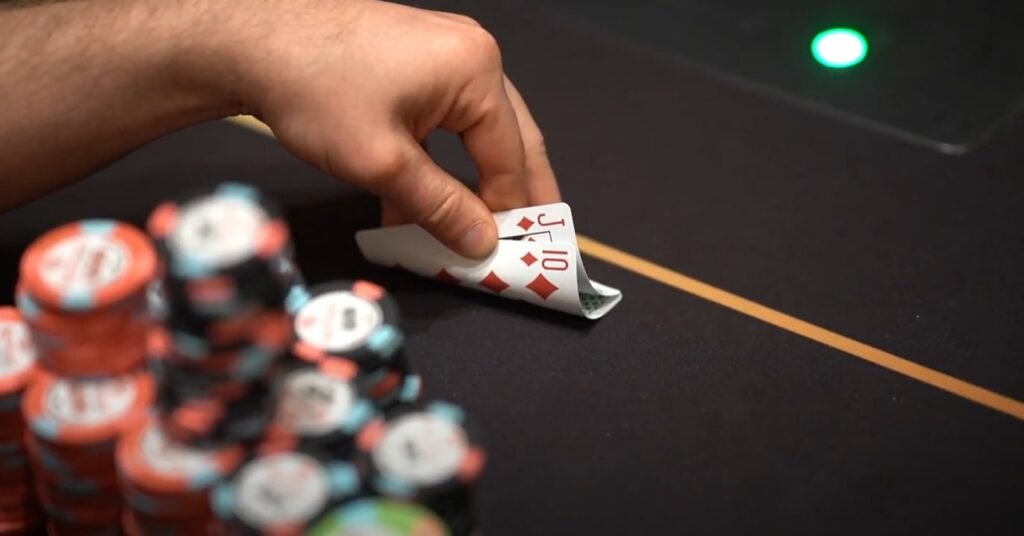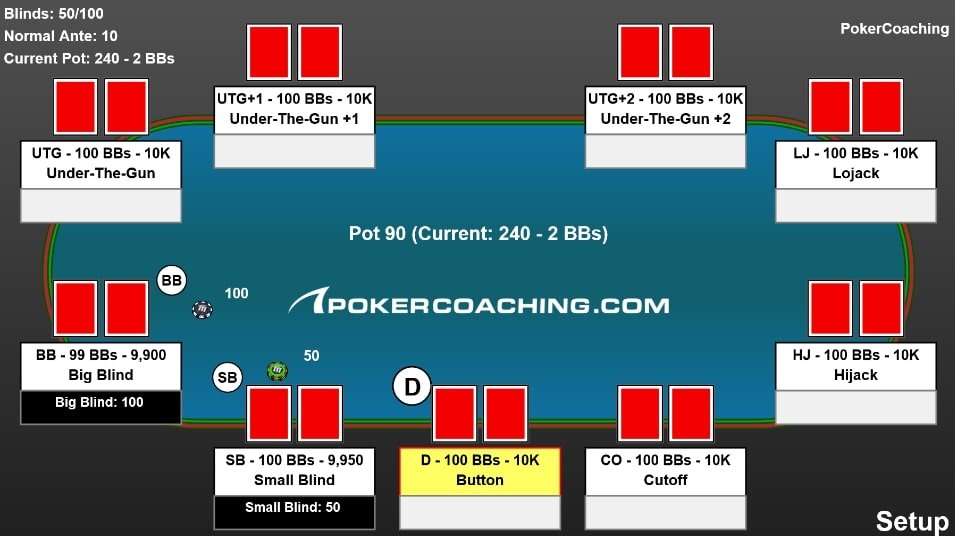This is a detailed guide on how to play Texas Hold’em. We will cover everything you need to know, from hand rankings to basic rules and betting action, so by the end of this article, you will know all Texas Hold’em rules and how to play the most popular poker variation.
The goal of the game is to make the best possible five-card combination by combining two hole cards and five community cards and winning chips from your opponents.
While Texas Hold’em rules are relatively basic and simple to master, there are many details you need to know before starting playing this game, so let’s dive straight into it.

How to Play Texas Holdem
Before we proceed to any specific rules of Texas Hold’em, it is important to understand what your goal in poker is and how you win in this game.
There are two basic ways to win in Texas Hold’em: either having the best five-card poker hand at showdown or getting all opponents to fold their cards.
Both ways of winning the hand are equally legitimate, and both will result in you scooping all the chips that were put into the pot by that point.
The size of the pot you win will depend on the actions you and other players take through the various betting rounds, as well as the stakes you are playing, which are determined by the forced bets (blinds and antes) at the start of the hand.
Blinds and Antes – Forced Bets in Poker
To get things started in poker, two players at the table must post the blinds; forced bets designed to initiate action and give everyone else a reason to put chips into the pot.
Before a hand can start, one player must be assigned as “the dealer.” This player is marked by the dealer button, which sits on the table in front of them for the duration of the hand.
The two players sitting to the left of the dealer must post the small blind and big blind, the two main forced bets in Texas Hold’em.
In tournaments and sometimes in cash games, players are also asked to post ante bets, which can either be posted by every player at the table or by one player per hand for the entire table.
The blinds and antes are all predetermined. In cash games, the blinds do not change as the game progresses, while in tournament poker, they increase with each tournament level.
For example, in a $1/2 cash game, the small blind must post $1, while the big blind must post $2 to get things started.
It is also worth noting that the dealer button and the blinds move one position to the left every hand, so every player pays the same amount of blinds and antes per orbit.
Texas Hold’em Rules – Betting Rounds

Once the blinds and antes are set, the game can start. The dealer deals two cards, face down, to each player at the table. These are called hole cards, and they are not to be revealed before showdown.
After the hole cards are dealt, every player at the table, starting with the one to the left of the big blind, is given a chance to act on their hand. We will expand on the actions you can take in each round in further text.
According to the rules of poker, there is a total of four betting rounds, followed by the showdown. These are:
- Preflop: The preflop betting round is the first betting round, which follows the dealing of hole cards. At this point, players can only see two cards and must make their actions based on very limited information.
- Flop: The dealer deals the first three community cards in the middle of the table, called the flop. Players act on their hands, with five cards at their disposal, starting with the player closest to the left of the button.
- Turn: The dealer deals the next community card, called the turn. Once again, all active players get to act on their hands in the same order as they did on the flop.
- River: The dealer deals the final community card, called the river. With all seven cards at their disposal, players get to act on their hand one last time before the showdown.
Following the four betting rounds in the Texas Hold’em poker game, the dealer will announce a showdown, prompting the remaining players to reveal their hole cards.
Once the cards are revealed, the dealer compares all the hands and declares the winner based on the standardized poker hand rankings.
If two or more players have the same hand, according to the rankings, the pot will be split into two or more parts and shared equally among the winners.
In case everyone but one player folds before reaching the showdown, the last remaining player is awarded the pot despite his holdings.
Limit, Pot Limit, and No Limit Poker
Texas Hold’em rules define many different things, including the betting limits, which determine the way in which players can make bets and raises in each betting round.
These days, No Limit poker is most commonly played, especially No Limit Texas Hold’em. In No Limit poker, there are no limitations to how much you can bet or raise at any point, except for your stack size, which is the maximum you can bet.
Pot Limit poker has been popularized by the rise of Pot Limit Omaha, another poker game that’s been widely spread in recent years. In Pot Limit Poker, players can bet or raise the maximum of the current pot size at any point, and the dealer is obligated to monitor the size of the pot and help players make the correct bets. That said, the Texas Hold’em game is rarely played as a pot-limit.
In Limit Poker, which is usually played in Mixed Games these days, players can only make bets and raises in preset increments, which significantly changes the strategic approach one must take to the game.
Poker Hand Rankings
Poker hand rankings are an integral part of the rules of poker, and the same rankings are used in most poker variations, not just Texas Hold’em.
The following are the best possible hands in poker, ranked from strongest to weakest:
- Royal Flush: The best hand in poker, a royal flush is made up of the five highest-ranked cards of the same suit. For example, A♦ K♦ Q♦ J♦ T♦.
- Straight Flush: Made up of any five consecutive suited cards, Straight Flush is the second-best hand in poker, and holding one means you almost always have the winner. For example 9♠ 8♠ 7♠ 6♠ 5♠.
- Four of a Kind: Four cards of the same rank make for a true powerhouse in poker. Almost always the best hand, Four of a Kind is also known as Quads. For example, Q♠ Q♦ Q♥ Q♣ T♦.
- Full House: Three cards of one rank and two of another make up a Full House. For example, A♠ A♦ A♣ J♥ J♣
- Flush: A flush is made up of five cards of different rank but same suit, regardless of their rank. For example, K♥ J♥ 9♥ 7♥ 2♥.
- Straight: Holding five cards of different suites but consecutive ranks gives you a Straight, powerful poker hand in its own right. For example, 8♥ 7♠ 6♦ 5♣ 4♠
- Three of a Kind: Also known as Trips, Three of a Kind is a poker hand made of three cards of the same rank, along with two other unpaired cards. For example 8♠ 8♦ 8♣ 5♠ 2♦.
- Two Pair: A hand made up of two different pairs of equally ranked cards, along with one unmatched card called the kicker. For example, T♠ T♦ 7♥ 7♣ A♦.
- One Pair: The weakest “made hand” in poker, One Pair is made up of two equally ranked cards, along with three unpaired cards on the side. For example, K♦ K♣ T♠ 5♥ 3♣.
- High Card: If your cards are all unpaired, and you hold no Straight or Flush, you will be left with just a High Card combination. If multiple High Card hands are left at the end, the player with the highest High Card wins. For example, A♠ Q♦ 9♥ 6♠ 3♠.
Knowing poker hand rankings by heart is the first thing you should master when learning poker strategy since you should be able to identify all possible combinations in the hand by simply glancing at community cards.
Texas Hold’em Actions Explained
We have already talked about the different betting rounds in poker and the fact that players must take action on their hands in each of these betting rounds.
Now, it is time to explore the different actions that are possible and their functions within the game of poker.
The following is a list of possible actions each player can take when the option comes to them in each of the betting rounds:
- Fold: The simplest of all poker actions. Folding means throwing away your hole cards and exiting the hand. Once you have folded your cards, you can no longer win the hand, but you can’t lose any more chips either.
- Call: When you announce a call or throw in the chips to make the call, you are matching the current bet without putting in further chips. In the preflop betting round, you will have to at least call the value of the big blind to remain in the hand.
- Raise: If you think you have a strong hand or are looking to make other players fold their cards, you can raise the bet up instead of calling. In No Limit Texas Hold’em, you are allowed to raise the bet to any amount, up to table stakes.
- Check: In all betting rounds except preflop, players are allowed to check when they are not facing a bet. Checking transfers the action to the next player and does not require any chips to be invested. Simply tap the table, and the action will move on for the time being.
- Bet: If you are not facing a bet, you can choose to make the first bet instead of checking. You can bet a minimum of one big blind and a maximum of your entire stack in No Limit Texas Hold’em.
- All In: While this action is identical to betting or raising, it is considered a unique action because it requires you to commit all your chips. Announcing all in will tell the dealer that you are betting all your chips, regardless of how many you have.
Knowing how to pick the right action will require some studying, but if you are just starting in the game, make sure to check our article with the best poker tips.
Positions in Texas Hold’em

Another important element of the game of poker is poker positions. Poker positions change from hand to hand as the dealer button circles the table, giving every player a chance to play each seat once per orbit.
Your position has nothing to do with the place at the table you are sitting at, as the position we are talking about is your position relative to the dealer button.
Generally speaking, we can split poker positions into early positions, middle positions, late positions, and blinds.
- Early Positions: The first three positions at a 9-handed poker table are considered early positions. These are marked as Under the Gun (UTG), UTG +1, and UTG+2. These positions generally require tighter play, as there are many players left to act after you.
- Middle Positions. Marked as MP1 and MP2, the next two positions at the table are considered middle positions. These positions are sometimes also called the Lojack (LJ) and Hijack (HJ) by poker analysts.
- Late Positions: The best positions at the table, from a strategic point of view, the Cutoff (CO) and the Dealer (D), allow you to act last in every postflop betting round, giving you a significant advantage. Late positions are the most favorable and allow you to play the most hands profitably.
- The Blinds: The Small Blind (SB) and Big Blind (BB) start the hand with a significant disadvantage. Not only do they have to invest money before seeing their hole cards, but they must also act first in every postflop betting round. Be careful when playing hands from the blinds!
This is a very simplified version explaining the different seat groups at the table, so make sure to check our dedicated guide about poker positions if you are looking to learn more.
Cash Game vs. Tournament Poker

Before you start playing, you should understand the difference between cash game and tournament poker, two of the most popular game formats.
The main difference is quite simple and doesn’t really have too much to do with the basic Texas Hold’em rules, which remain the same for the most part in both formats.
In cash games, players purchase chips for cash, the blinds are set at a certain level, and each new hand is dealt with the same blinds, regardless of how long the game goes on.
Cash games often have minimum and maximum buy-ins, and they allow players to purchase new chips when they lose or to top up their stacks when they lose a portion of their chips, with each chip bought for real money.
In tournaments, on the other hand, a fixed buy-in will get you a starting chip stack, which doesn’t directly reflect the monetary value you paid for it. If you lose all your chips, you are out of the tournament and can’t compete for the prizes.
What’s even more, tournament chips have no cash value and cannot be cashed out at any time. At the end of the tournament, players who came in the top 10%, 15%, or another predetermined percentage of the field are paid cash prizes.
The first-place finish in a poker tournament generally takes the biggest part of the prize pool, while other players who finish “in the money” are paid based on their finishing position.
Blinds in a poker tournament keep growing over time, which inevitably leads to players busting out of the tournament until only one player is left as the champion.
Mastering Texas Hold’em Basics
We briefly covered basic poker rules and all of the topics you must understand before sitting down to play Texas Holdem. Now you know how to play poker and will not be lost next time you sit at the table.
If you want to study more advanced strategies and deepen your understanding, make sure to check our GTO poker guide.